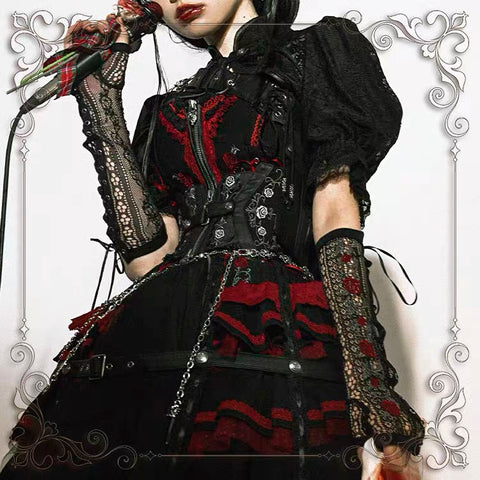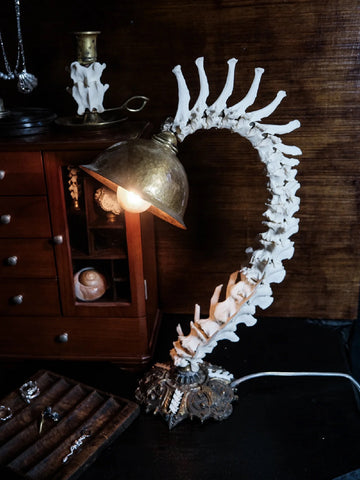No, Gothic fashion does not have to be exclusively black. While black is often associated with Gothic fashion due to its connection to darkness, mystery, and the macabre, Gothic fashion encompasses a broader range of elements and colors.
Gothic fashion is characterized by its dark and dramatic aesthetic, drawing inspiration from various sources such as Victorian and Edwardian fashion, punk subculture, and elements of horror and fantasy. While black is commonly used as a primary color in Gothic fashion, other colors can also be incorporated, albeit often in darker shades.
Deep jewel tones like burgundy, purple, emerald green, and navy blue are commonly seen in Gothic fashion. These colors maintain the overall dark and moody atmosphere while adding a touch of richness and variety to the outfits. Additionally, accents of red, white, silver, or gold can be incorporated for contrast and visual interest.
Ultimately, Gothic fashion allows for creativity and personal expression, so while black is a staple, it doesn't have to be the sole color used. Feel free to experiment with different shades and combinations to create a unique Gothic style that reflects your individual taste.
Here are some additional aspects of Gothic fashion that go beyond color:
-
Silhouettes: Gothic fashion often incorporates unique and dramatic silhouettes. This can include corsets, flowing or layered skirts, bell sleeves, high collars, and asymmetrical designs. The aim is to create a visually striking and sometimes exaggerated look.
-
Fabrics: The choice of fabrics in Gothic fashion tends to favor luxurious and textured materials. Velvet, lace, satin, brocade, leather, and fishnet are commonly used. These fabrics add depth, richness, and a tactile element to the outfits.
-
Accessories: Accessories play a significant role in completing a Gothic look. Items such as chokers, spiked or studded jewelry, Victorian-style cameos, lace gloves, wide-brimmed hats, parasols, and ornate hairpieces are often incorporated. These accessories contribute to the overall Gothic aesthetic and help to enhance the theme.
-
Makeup and Hairstyles: Gothic makeup often features pale or porcelain-like skin, dark or bold lip colors (such as deep red or black), smoky or heavy eye makeup, and sometimes dramatic face contouring. Hairstyles can range from sleek and elaborate updos to tousled, wavy, or asymmetric styles. Dyed hair in various dark shades, such as black, purple, or burgundy, is also common.
-
Symbolism and Themes: Gothic fashion frequently incorporates symbols and themes associated with the macabre, occult, and Gothic subculture. This can include elements like crosses, bats, skulls, spiders, pentagrams, roses, Victorian motifs, and religious iconography. These symbols add depth and a sense of mystique to the overall aesthetic.
Remember, Gothic fashion is a form of self-expression, and there is room for personal interpretation and creativity within its broad aesthetic. It is a style that embraces darkness, romanticism, and individuality, allowing individuals to explore their unique fashion preferences while being inspired by Gothic influences.
While black is commonly associated with Gothic fashion, there are other colors you can incorporate to add variety and personal flair to your outfits. Here are a few suggestions:
-
Deep Red: Dark or blood-red shades can bring a bold and intense element to your Gothic look. They evoke a sense of passion, drama, and even a hint of danger.
-
Purple: Deep purple hues like plum, aubergine, or royal purple can add a regal and mystical touch to your Gothic outfits. Purple has long been associated with luxury, spirituality, and the supernatural.
-
Burgundy: This rich, dark red color has a sophisticated and vampiric feel to it. It pairs well with black and can add depth and warmth to your Gothic ensembles.
-
Emerald Green: Deep, dark green shades can create a striking contrast against black. This color brings to mind lush forests, mystery, and a touch of enchantment.
-
Navy Blue: While still a dark color, navy blue offers a subtle variation from black. It adds depth and elegance to your Gothic outfits while maintaining a sense of sophistication.
-
Charcoal Gray: If you prefer a softer alternative to black, charcoal gray can be a great option. It has a muted and understated quality while still maintaining the dark aesthetic of Gothic fashion.
Remember, the key is to choose shades that align with the dark and moody atmosphere of Gothic fashion. These alternative colors can be incorporated into your outfits as accent pieces, such as in accessories, shoes, or specific garment details, while still maintaining the overall Gothic aesthetic. Experiment and have fun creating your unique style!





